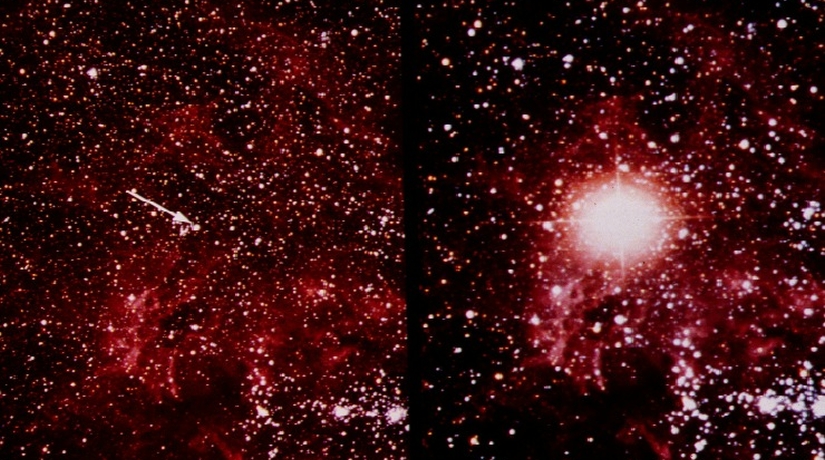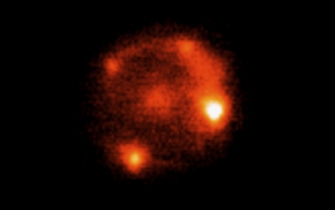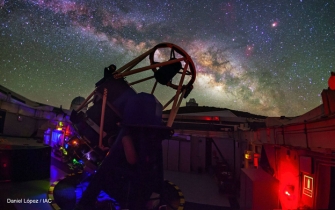
Back in 1987, astronomers observed a stellar explosion, known as a supernova so bright, it could be seen with a naked eye. The last such event happened more than 400 year earlier. This is an image of the sky before and after supernova 1987a happened. Image credit: Anglo-Australian Observatory.
2017
5 SeptDear supernova, what exactly are you?
The detective journey of a Growth summer student uncovered a supernova of a truly peculiar nature. It was brighter than most supernovae, but dimmer than their more energetic cousins, superluminous supernovae. Its explosion spread star material at really high velocities, but it didn’t have any of the other signature characteristics of powerful events known as gamma-ray bursts that eject materials in outward jets at comparable speeds. As astronomers keep dissecting the cosmos at increasingly finer scales, are we set to find that the few well-known supernovae categories represent but a tiny set of what is out there?
One summer night last year, while most of us were peacefully sleeping, a tireless robotic telescope at the Palomar Observatory was scanning the skies looking for anything that changed in the night sky. In a dwarf galaxy, approximately 2.5 billion light years away, it noticed and recorded in its database a powerful flash of light under the name iPTF16asu. The initial data suggested that this is a rapidly evolving supernova, so the GROWTH team decided to keep observing and get more data. They triggered observations with the much bigger 60-inch and 200-inch telescopes at Palomar as well as several other GROWTH facilities around the world.
Caltech undergraduate Lindsey Whitesides joined the GROWTH summer research program at the perfect moment to start, what turned out to be an engrossing investigation on iPTF16asu using the wealth of data gathered by the GROWTH telescopes. As a start, the light curve of iPTF16asu - a curve that depicts the change in supernova brightness with time – didn’t quite look like anything they had seen before. Most supernovae have light curves that first rise until they reach a peak and then fall down. How fast a light curve rises and falls, as well as how bright and broad its peak is provide astronomers with clues about the type of supernova and the physics behind the star’s explosion.
“The very initial part of the light curve and the maximum brightness we observed, suggested that we may be seeing a superluminous supernova. However, it rose to peak brightness in only 4 days, which is really fast for any class of supernova we know of. This was puzzling and I knew I was hooked. I needed to find out more,” - says Lindsey Whitesides, a Caltech undergraduate and a GROWTH summer student who is the lead author of the study, accepted for publication in the Astrophysical Journal.
In addition to the surprisingly rapid rise of the supernova brightness, the team also measured unusually high velocity, with which the exploding stellar material was moving through space. Astronomers believe that this can happen when a compact central object is formed after the explosion. This dense core then provides the energy needed to push the remains of the star at such high speeds. The scenario when the stellar material forms two powerful jets that move with speeds closer to the speed of light, is referred to as a gamma-ray burst. The declining part of the iPTF16asu light curve resembled a so called type Ic-broad line supernovae, some of which have been associated with gamma-ray bursts. However, the intense optical signal from gamma-ray bursts is accompanied by X-ray and radio emission days to weeks after the optical signal fades away. However, Lindsey and her team did not find any such radiation when they sieved through X-ray and radio data from the Swift and VLA telescope. The mystery still stood unsolved.
“This supernova is quite unique in its combination of properties: very luminous, very rapidly evolving, and very high velocities, “ - says Ragnhild Lunnan, a postdoctoral fellow at the University of Stockholm – one of GROWTH’s eight international partners.
“There are not many examples of such fast supernovae, mainly because they are hard to find in traditional supernova searches because such discoveries require very fast scanning and rapid follow-up with more powerful facilities. This is one of the first examples of such a fast supernova, where we have good multi-wavelength data and spectroscopic coverage. With more such data, we can begin to find out what actually happens in weird supernovae like iPTF16asu.” -adds Lunnan.
Future astronomical surveys such as the Zwicky Transient Facility at Caltech hold a lot of promise to push deeper into the uncharted territory of non-standard transients in the coming few years. With the LSST, expected to start operations in 2019, astronomers may finally get a much more complete picture of the diverse types of supernovae that flash in the dark skies and uncover the physical mechanisms that drive these spectacular stellar deaths.
Lindsey Whitesides is now convinced that few things are as exciting as solving mysteries that happen somewhere out there in the vast Universe. She will soon move to University of Maryland, College Park to begin her PhD studies in the broad field of time-domain astronomy.
“It’s exciting! There is so much we have learnt about space in the last one century. Yet, we ultimately know so little. We’ll never run out of interesting questions.” - says Lindsey.
Contact
Iva Kostadinova
GROWTH Communications and Media Contact
ivonata@caltech.edu
+1 626 395 2952




